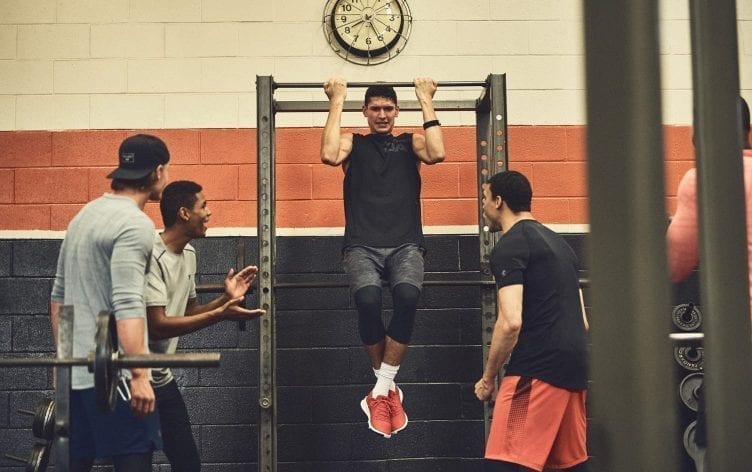How Long Regain Muscle Mass Lifting Again
How Quickly Can You lot Regain Strength Subsequently Taking a Break?
by Lauren Bedosky
June 26, 2019

Getting ill, being injured or just needing a pause are all valid reasons to occasionally have time away from your workout routine. But sometimes these breaks last longer than we anticipate and many of united states of america worry we'll lose all the strength nosotros worked so hard to build and end upward starting back at square ane.
It's safe to say taking a recovery twenty-four hour period is considered best practice for a responsible training routine. So, while a 24-hour interval is great, how about a week? What nearly a month? How chop-chop exercise you lose strength once you stop training? The answer might non be as fast as yous remember: "Most experts agree that big losses in forcefulness don't happen for nearly 3 months, with smaller, less significant losses starting around iii–4 weeks," says personal trainer Ashleigh Kast, a NASM performance enhancement specialist.
A review published in Sports Medicine, for example, found aristocracy rugby and football players could go three weeks without training earlier their forcefulness levels started to pass up. Similarly, research on non-athletes constitute they were likewise able to take three weeks off from preparation without seeing whatsoever declines in strength or musculus mass.
Fifty-fifty if yous have to take equally much equally three months off from training, rest assured information technology won't have you too long to regain your forcefulness — especially if you were training consistently before your hiatus.
Exactly how long it takes to regain your forcefulness is hard to say, considering it takes more than muscular strength to pull off an exercise. For case, if you could deadlift 300 pounds for half-dozen–7 reps, and so y'all took three months off from training, you may still be able to lift 300 pounds when you return to grooming — just not for 6–vii reps.
Similarly, if you could do xv pullups before your three-calendar month break, you could probably knock out several pullups when you hop up to the bar over again, but you may need to work back upwards to 15.
The reason actually has a bit less to practise with a loss of strength as it does a loss of endurance. "Doing pullups involves much more than than your muscles, it besides involves cardiovascular capacity, peculiarly if you get into the higher reps," says Dr. Laith Jazrawi, professor of orthopedic surgery and chief of the sports medicine division at NYU Langone Orthopedic Center.
Equally you do more than reps of an practice, your trunk builds up waste material products similar lactic acid in the muscle. With more preparation, your torso becomes more than efficient at immigration out the waste product products and so yous can complete your reps without fizzling out, just if you don't exercise for a while, it takes a petty fourth dimension to build upward that endurance again, Jazrawi says.
See, cardiovascular fettle is i of the first things to go when yous terminate exercising, with noticeable declines happening within 4 weeks. For case, a recent study reveals four weeks of detraining led recreational marathon runners to lose roughly 3.6% of blood volume, which other research suggests may exist the primary cause for early losses in cardiovascular chapters. But keep in mind that how quickly you lose and regain cardiovascular fitness may depend on how long y'all've been training.
When information technology comes to force, nevertheless, you'll generally go on it for much longer, and be able to rebuild information technology adequately quickly. The reason: Your muscles "remember" the prior adaptations they made from strength grooming and can become back up to speed in less time than it took to create those adaptations in the first place.
Although it's hard to offering a concrete timeframe, you may be able to regain the strength lost from 3 months of detraining in merely a couple of months. Ane study found elderly men who paused their training for 12 weeks were able to rebuild the strength they'd lost (roughly 35%) in only viii weeks.
If you're restarting your strength-training routine after a hiatus, start with lighter weights or fewer reps (if doing bodyweight exercises) than yous're used to. Increase the weight gradually to give your tendons time to regain their elasticity.
Encounter, yous don't simply lose force in your muscles when yous take an extended intermission from lifting; y'all likewise lose elasticity in your tendons (these adhere muscle to bone), Kast says. When your tendons are elastic, they're better able to produce and absorb force during high-touch on movements, such as sprints, plyometrics and heavy weight grooming.
Co-ordinate to Jazrawi, some patients get right back to lifting heavy weights while their tendons are however strong: "That'due south where they run the risk of violent or breaking," he says. So, any you do, don't try to choice upwards where you left off.
About the Author
![]()
Lauren Bedosky Lauren is a freelance fitness writer who specializes in covering running and strength preparation topics. She writes for a diverseness of national publications, includingMen's Wellness,Runner's World,SHAPE andWomen'southward Running. She lives in Brooklyn Park, Minnesota, with her husband and their three dogs.
Related
Source: https://blog.myfitnesspal.com/how-quickly-can-you-regain-strength-after-taking-a-break/
0 Response to "How Long Regain Muscle Mass Lifting Again"
Post a Comment